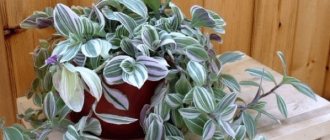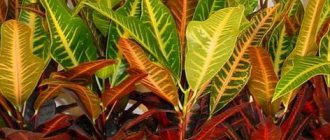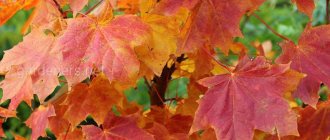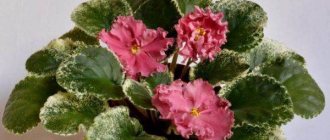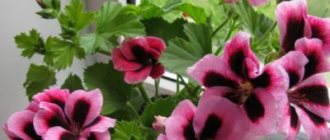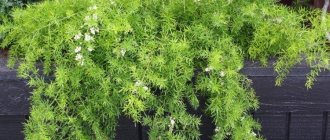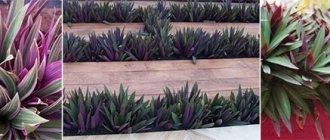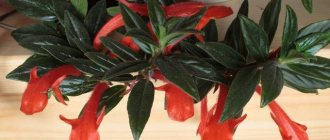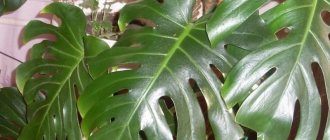Abutilon belongs to the Malvaceae family and is valued primarily for its beautiful and long flowering - some hybrid abutilons can bloom from spring to late autumn. There are more than 200 species of abutilones in nature (1), they are distributed mainly in the tropics, but one species, Abutilon theophrasti, is found in the southern regions of the European part of Russia - this is a malicious weed that most often settles in sugar beet fields.
Varieties and hybrids of various species are grown indoors, but there are also garden varieties of abutilon that can be grown as annuals (in warm regions and as perennials) in open ground.
Abutilon flowers are white, pink, red, yellow and orange, and there are varieties with contrastingly colored petal veins. There are variegated forms of abutilone with spotted and “marbled” leaves. The sizes of plants are also varied: depending on the variety, abutilon can be compact (20 - 25 cm) or tall, up to 70 cm tall (2).
Abutilone varieties
There are many varieties, but their range in stores is vanishingly small. Only breeders or collectors have a good selection of varietal plants, so it is better to purchase indoor maple from them.
Varieties of imported selection are common in Russia, but private breeders are successfully working to obtain domestic varieties. There are abutilon seeds on sale, but their range is also small - they are often offered in the form of mixtures of seeds of different varieties.
- Kirsch Orange. Miniature abutilon is about 25 cm high, the flowers are simple, five-petaled, light orange with pink veins, 4 - 6 cm in diameter. The leaves of young plants are ovoid, eventually becoming three-lobed.
- Roter Jewel. Medium-sized, up to 60 cm high. Flowers are bell-shaped, drooping, up to 10 cm in diameter. The color of the flowers is bright red, with a “satin” effect and darker veins. Young leaves are characterized by variegation; as they grow, they become green.
Roter Jewel. Photo: commons.wikimedia.org
Aureo-maculatum. Photo: pixabay.com
- Yellow Trumpet . A large bush with spreading shoots up to 70 cm long that can creep. The flowers are gramophone-shaped, bright yellow, drooping, up to 4 cm in diameter. Due to the long peduncles, the flowers look like hanging bells.
- Aureo -maculatum. A very unusual abutilon with pronounced “maple-shaped” leaves and strong variegation: the leaves are covered with a whitish pattern of spots and veins. The flowers are orange, bell-shaped, slightly drooping, solitary or in inflorescences of 2–3 pieces, up to 4 cm in diameter. Plant height is up to 50 cm.
Botanical description
The height of the tree is usually 12-15 m, but can reach 21 m. The thickness of the trunk is 30-60 cm, but sometimes 90 cm. The crown is not symmetrical. Often the main trunk close to the base is divided into several spreading shoots if the wild ash maple grows in open space. In a close group it has a sparser crown and stretches upward more strongly. The root system is fibrous, superficial, producing dense growth. Life expectancy is up to 100 years.
The trunk is covered with thin, light gray or brown bark, covered with shallow grooves. Young branches have green bark with noticeable grey-green pubescence. The buds are white, pubescent. The leaf shape is complex, imparipinnate, formed by 3-13 leaflets (on average 15-18 cm long) on a petiole up to 8 cm long. The color of ash maple leaves is light green above and silvery-white below. The surface of the leaf plates is smooth, the edges are serrated. In autumn the foliage turns yellow.
Ash maple is a dioecious plant; the tree can bear only male or only female flowers. Male ones form drooping tufts on a thin petiole. Their anthers are reddish. Female inflorescences form a cluster of yellow-green color. Flowering lasts from late May to June for about 15 days. Pollination occurs mainly by wind, partly by insects.
Like other members of the genus, American maple seeds are equipped with two wings diverging at an angle of 60°. The length of the wings is about 4 cm. Seed ripening lasts from August to October. Each tree is capable of producing a harvest of up to 50 thousand lionfish. They are attached to branches with strong petioles, so they almost always remain on the tree until spring, attracting birds.
Varieties of ash maple
Shrubs that are a hybrid of the natural form of the American maple are planted everywhere in gardens and parks. Nurseries in Poland and Western Europe supply the following popular varieties:
- Auratum - distinguished by its curved trunk and branches, as well as the bright yellow color of its leaves from spring to autumn; the Odessanum variety is similar to it, but its crown is more rounded;
- Aureo-variegatum - its foliage is of a traditional green hue, but colored with rich yellow stripes;
- Flamingo is one of the most elegant varieties with green leaves, on which white and pink specks are randomly scattered;
- Variegatum - the crown of this variety looks unusually voluminous, since the green leaves are framed by a white border;
- Elegans - the variety differs from Variegatum in the shade of the border on the leaves, it is yellow;
- Aureovariegatum - very similar to Flamingo, but on its foliage the spots are colored only yellow;
- Violaceum is a shrub of extraordinary beauty with purple shoots.
Caring for abutilone at home
The abutilon flower is not considered the most capricious to care for, but you need to know some of the subtleties of its cultivation. The main thing to consider if you decide to grow abutilon is its final size, since tall varieties can take up quite a lot of space not only due to the height of the bush, but also due to its width.
Lighting
Abutilon prefers bright light, but can be damaged by direct midday sun, so it should be positioned so that it receives several hours of sunlight in the morning or evening.
You can grow indoor maple in slight shade, but then the flowering may be less abundant. Variegated varieties of abutilon remain decorative only in constant bright light; in the shade, their leaves lose color.
In winter, when daylight hours are short, abutilon may require additional lighting with a phytolamp.
Temperature
This is an important point in flower care. Abutilones prefer cool conditions and can suffer from too high temperatures, especially in summer when it is hot, and in winter if the plant is close to heating devices. The permissible range of room temperatures for the plant is about 20 °C in winter and up to 25 °C in summer, while abutilone tolerates cold more easily than heat. In summer and early autumn, it is best to keep abutilon on the balcony; nighttime drops in temperature only benefit it if it does not fall below 10 °C.
Cold drafts and supercooling of the soil in the pot in winter are definitely harmful to abutilone. If abutilon grows on a windowsill, during the winter it is advisable to move the pot away from the cold glass as far as possible and isolate it from the windowsill - for example, using a wooden stand.
Priming
The soil for abutilon should be slightly acidic, loose, and breathable. Specialists in growing these plants prepare the soil mixture themselves from a mixture of leaf and turf soil, peat, humus and sand in a ratio of 2:1:1:0.5. Another soil mixture recipe is high-moor peat, vermicompost, charcoal and coconut substrate in approximately the same proportions.
If you cannot prepare the soil yourself, you can use ready-made commercial soil for begonias.
Before planting, home-made soil must be disinfected. Good quality purchased soils do not require pre-treatment.
Humidity
Abutilones are quite tolerant of room humidity levels, but periodic spraying is beneficial for them and serves as a preventive measure against pests. In hot weather, plants should be sprayed in the morning and evening, since water droplets act as collecting microlenses and can cause leaf burns. In winter, spraying is continued to compensate for the dry air in the room, but this is done less frequently than in summer.
Another point that should definitely be controlled when caring for a flower is watering. Abutilone is moisture-loving and requires frequent, abundant moisture in the warm season. The plant reacts very quickly to a lack of moisture by losing leaf turgor and dropping buds.
Photo: commons.wikimedia.org
In hot weather, experts recommend watering abutilon little by little but often. In the cold season, indoor maple is watered less frequently; the top layer of soil should dry out between waterings. If abutilon is kept in cool conditions in winter (on a balcony or terrace), watering should be very moderate, without through-wetting the soil.
Water abutilon with well-settled soft water; sometimes it is useful to add a few drops of lemon juice or citric acid to the water for watering.
Fertilizers
Abutilone is suitable as a liquid organomineral fertilizer for flowering indoor plants. Some gardeners alternate fertilizers: outside the flowering period they apply compositions for decorative foliage plants, and in the budding phase and during flowering they switch to fertilizers for flowering crops.
Feeding
During the active growing season, from mid-spring to early October, fertilizing is applied once every 3 weeks along with watering. Periodic foliar feeding on the leaves is also useful for abutilone.
In winter, feeding is not stopped, but it is applied approximately 2 times less often; at this time it is better to feed abutilon by leaves. Plants kept cold in winter are not fed.
Trimming
Regular pruning is very important to maintain the decorative appearance of abutilon: during the growing season it grows very quickly, large varieties are capable of growing up to 50 cm per season.
Abutilon is pruned in late winter - early spring. The shoots are shortened by 1/3 or even 1/2, all weak, sparsely leafy and growing in the center of the crown are cut off.
For sanitary purposes, throughout the growing season, dried and damaged shoots and dying old leaves can be removed. During flowering, faded flowers are periodically removed.
Features of growing abutilone in the country
To successfully grow abutilons in the garden, you need to carefully choose the planting site, as well as provide the plants with proper care. Indoor maples should be planted where it is warm, dry and has a lot of diffused sunlight. Abutilons are strictly contraindicated in bright midday sun, especially if they are located next to the wall of a house or a solid fence. With such lighting in the heat, the leaves simply “burn out” and the buds crumble before they have time to bloom.
Basically, flower growers perceive abutilon as a houseplant and, unfortunately, not the most attractive one. Meanwhile, in European floriculture this is a fairly popular garden and tub plant for landscaping the patio.
For good growth of abutilons, the soil should be light and moisture-absorbing, but not retaining water. To increase the nutritional value of the soil mixture, before planting, you can add vegetable compost or organic fertilizers mixed with a coarse fraction of sand as a “leaking agent”. They are also used in the future for feeding abutilons. The top layer of soil under the seedling should be mulched; this procedure will help prevent overheating and drying out of the root system, protect against weeds, and also reduce moisture evaporation.
Indoor maple can be grown in a personal plot both as an annual and as a perennial. In the first case, after the end of the gardening season, the plant is simply removed from the flower garden, in the second, it is sent for the winter, and with the arrival of spring it can become a mother plant for cuttings or continue to grow and delight with flowering as an independent adult bush.
Reproduction of abutilone at home
Indoor abutilon is propagated by cuttings, but you can also grow new plants from seeds - this is not particularly difficult.
By cuttings . For cuttings, non-lignified tops of young shoots are taken, so it is convenient to combine it with pruning. The length of the cutting is about 10 cm, it should have several leaves. The lower leaves are cut off, the cuttings are placed in a container with water and kept in a moderately warm, bright place. After the roots appear, the cuttings are planted in separate containers.
It is possible to root abutilon cuttings in the ground. To do this, the lower part of the cutting is dusted with a root formation stimulator and planted in moist soil consisting of sand and peat in a 1:1 ratio. The container with cuttings is covered with a transparent material, ventilated periodically, and the soil is moistened. Roots usually appear within a month, after which the cuttings can be planted in separate pots.
Seeds . As already mentioned, the range of abutilon seeds is small, and most often these are seeds of medium and tall varieties for growing in open ground. There is no point in trying to get your own seeds, since when hybrids are propagated by seed, the daughter plants do not inherit the characteristics of the parent plants.
Seeds can be germinated in a damp cloth - this allows you to immediately discard non-viable ones and not waste time on sowing them. The napkin is well moistened with warm water, the seeds are laid out on the surface and the container is covered with a lid with holes for ventilation. As the napkin dries, periodically moisten it. It usually takes 3 to 10 days for sprouts to appear. At the stage of two cotyledon leaves, seedlings are planted in separate containers.
You can sow the seeds directly into a container with soil. To do this, take a mixture of peat (or leaf soil) and sand. The seeds are buried no more than 3 mm, the soil is moistened with a spray bottle, the container is covered with transparent material and kept at a temperature of 18 - 20 ° C, periodically ventilated and sprayed. Sprouts usually appear in 15 - 20 days; after the first pair of true leaves appear, they are picked into separate pots.
It is possible to germinate abutilone in peat tablets - this eliminates the need for picking. The technology for sowing seeds in peat tablets is the same as in soil.
When to transplant abutilon from home to open ground
Young abutilon bushes are planted from pots into open ground, first of all, to speed up their development, because in this way, in one season, from a modest small bush you can get a spreading, lush-flowering tree. Abutilon, planted in the garden by cuttings, often reaches a height of about 1-1.5 meters in one summer.
When adapting to the garden, to begin with, plants are placed in areas protected from direct sunlight and strong winds. Do not place any indoor plants directly into a sunny place in the garden or on the porch of the house. If conditions change abruptly, they can get sunburned and even lose leaves.
It is advisable to plant large adult abutilon bushes in open ground to rejuvenate them and improve their appearance. In the fresh air in the garden, plants receive more light and nutrition, which means they become more lush, beautiful and bloom profusely.
Transplantation of abutilons is carried out using the transshipment method, that is, simply moving the bushes along with a lump of earth from pots into prepared holes. The planted plants are watered abundantly and then provided with standard growing conditions: regular watering, loosening, fertilizing with complex fertilizer 2 times a month. With the arrival of frost, abutilons are dug up, transplanted into pots and returned back to indoor living conditions.
Transplanting abutilone at home
Abutilons are replanted in late winter or early spring, during the dormant period. Young plants need replanting once a year, adults – once every 3 years. The pot should be only 2 - 3 cm larger than the previous one, even for plants with a highly developed root system: it has been noticed that abutilons bloom worse in spacious pots.
In general, what is desirable for abutilon is not replanting with complete cleaning of the roots from the old soil, but transshipment with part of the earthen coma: only the soil that comes off well on its own is cleaned off. The freed roots must be inspected for rot and carefully untangled.
When filling roots, the soil must be compacted. After transplanting, the plant is watered, and then it is useful to cover it with a transparent bag for 2 - 3 days to retain moisture - this reduces the stress of transplantation.
The variety of names for this flower
Home maple abutilon - indoor flower
The unusual flower with maple leaves is known by different names. The official name of the plant with maple-like leaves is abutilon. There are also other folk ones. Most often this flower is called maple, adding various adjectives:
- indoor;
- home;
- decorative;
- flowering.
Ropeweed can have different colors depending on the type and variety
A less common name is ropeweed, derived from its strong stem.
For your information! “Rope guy” is a literal translation from Indian. The flower is so called because in India and other countries of South Asia, since ancient times, its hard leaves and stems have been used to make twine, ropes, and coarse burlap.
Abutilon received the popular nickname rope for the strong fibers that make up the stem
Abutilone diseases
Abutilons rarely get sick and only with poor care. The most common ailments of abutilon are root rot and physiological chlorosis.
Root rot. It is caused by chronic waterlogging of the soil, especially in combination with unsuitable soil (dense, poorly drained, with poor aeration) and overcooling of the earth ball in the pot. Signs of root rot are a general weakening of the plant, wilting of leaves and shoots, falling of buds and flowers.
Abutilone with signs of disease should be removed from the pot, the root system should be washed from the old soil, all rotten roots should be removed and soaked for a while in a solution of potassium permanganate. After this, the roots are dried and sprinkled with activated carbon, the plant is transplanted into new soil, into a pot of the same size.
Physiological chlorosis. This is not an infectious disease of abutilon, but a consequence of a lack of nutrients or an imbalance in them. With chlorosis, the leaves turn pale unevenly, starting at the edges or spaces between the veins, then turn yellow. The veins remain green. Indoor maple may suffer from chlorosis due to insufficient feeding or incorrectly selected fertilizer.
When buying fertilizer for abutilone, pay attention to its composition: it must contain trace elements, primarily iron, magnesium, zinc and sulfur. Sometimes during the period of active growth, abutilone may lack nitrogen, which is necessary for the formation of green mass - in this case, you should switch to a fertilizer with a higher nitrogen content or increase the frequency of fertilizing, preferably foliar feeding.
If everything is in order with fertilizing, but abutilone still shows signs of chlorosis, the reason may be alkalization or excessive acidity of the soil. The soil can become alkalized when watered with poorly settled or extremely hard tap water, which contains a lot of lime. Too acidic soil is the result of excessive addition of acidifiers when watering or planting in an unsuccessful soil mixture.
Abutilon chlorosis should not be confused with the natural process of dying off old leaves. Old leaves are the lowest on the shoots, and as they age they turn yellow evenly. Spotted yellowness on young leaves is a clear sign of chlorosis.
Spreading
In the 20th century, American maple seedlings were planted throughout the USSR. The results were varied, leading to the spread of the species into the wild. In Ukraine, young shoots of trees freeze out in harsh winters, but planting continues, since maple is very resistant to drought. In Azerbaijan, in dry years, it does not bear fruit, but does not die. In the conditions of the Caucasus and Crimea, the ash-leaf maple grows, bears fruit and actively spreads to adjacent territories.
In many regions the species is used for landscaping. For example, in Kazakhstan it is found everywhere, as in the Baltic states and Belarus. In Moscow you can admire specimens planted in the 1950s. Ash-leaf maples are also planted further north - in St. Petersburg, Arkhangelsk, Petrozavodsk.
Seeds are carried by wind and birds. Having fallen into the soil, they emerge most quickly along roads, in abandoned pastures, and in industrial areas. Now wild ash-leaved maple shrubs and trees can be seen in nature reserves and wildlife sanctuaries, where they successfully compete with plants traditional for this area.
Pests of abutilone
All common pests of indoor plants are typical for abutilone: spider mites, scale insects, whiteflies, thrips, mealybugs. Signs of pests on abutilon are spotty discoloration and wilting of leaf blades, a “cotton” or cobwebby coating on the back of the leaves and on the shoots, curling of young leaves, dark small “growths”. Many pests can be seen with the naked eye or through a magnifying glass.
In case of weak pest infestation, it is recommended to wash the abutilon several times with green soap; the scale insects are removed mechanically.
If the pests have thoroughly multiplied on the plant, it is necessary to treat it with agrochemicals:
- from aphids and whiteflies - Fitoverm or Actellik (3);
- from scale insects, thrips and spider mites - Aktara (3).
The soil in the pot also needs to be treated with these preparations. And in case of severe thrips infestation, it is better to transplant the plants into fresh soil.
Planting and care
Two-year-old seedlings 70-100 cm high of decorative varieties take root in almost any soil, but prefer well-drained soils rich in peat. The site can be set aside in almost any free corner of the garden or park, taking into account the tendency of the crop to produce abundant root growth. The optimal distance between trees is 2-4 m.
When planting, the root collar is not buried; it should be flush with the ground level. The soil around the trunk is generously mulched with peat and watered. To stimulate growth in the spring, mineral fertilizers are applied alternately: superphosphate, potassium salt and urea. An adult plant does not need watering if there is sufficient rainfall, but young ash-leaved maples require it - 15 liters per month per tree.
Botanical and indoor types of abutilone
Under natural conditions, one of the most common varieties of the crop is the Chitendeni variety, which grows massively in South America. Main characteristics of the variety:
- powerful and strong branches with a large number of shoots;
- maximum height 3 m;
- Dark green foliage is round, large in size, not hard, with soft pile on the underside;
- The buds are round and orange in color interspersed with bright scarlet stripes.
Home indoor flower with purple leaves
Externally, the plant resembles the Tiger's Eye variety, characterized by a large opening of flowers and an increased diameter of the buds.
Among indoor flowers with maple-like leaves, the following common options are distinguished:
- terry;
- spotted;
- hybrid;
- Savitsky.
Indoor varieties can vary in size; among the varied forms there are both dwarf and giant plants. Memorable “dwarfs” include Bella, reaching up to 30 cm. The buds look like inverted glasses, framed by a velvet border. The petals have a large number of tones: pinkish, yellowish, orange, burgundy and blood-purple.
Note! Popular subspecies include the dwarf Savitsky variety. The plant is distinguished by scanty buds, similar to bird cherry. The variety has become widespread due to its ability to easily adapt to any unfamiliar conditions and its pronounced unpretentiousness.
Abutilone megapotamian
